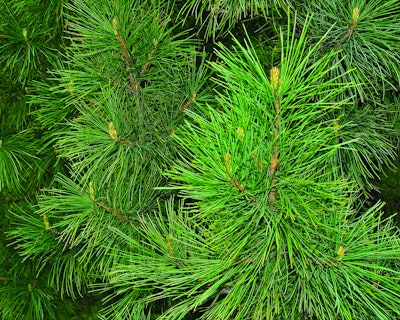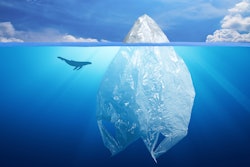In Part I of Packaging World’s Biopolymers Special Report in the November 2017 issue, we discussed the “bounty of options for biopolymers.” While the article covered a number of advancements, the market is still a nascent one, albeit one expected to grow exponentially in the coming years.
According to a new report from Smithers Pira, bioplastics for packaging currently represent a very small share of the global plastic packaging market value. But, it estimates, the bioplastic market will more than double in value from 2017 to 2022, growing at an average rate of 17% per year, to a market value of $7.2 billion.
Part I of this report explored some of the more established materials in the market, including polylactic acid (PLA), bio-PET, and bio-PE. Here, we will continue the march through the alphabet soup of bio-based plastics, looking at one category that has been in the market for a while—TPS, or thermoplastic starch—and two emerging technologies: PHA (polyhydroxyalkanoate) and PEF (polyethylene furanoate). As with Part I, this article does not purport to cover every material and supplier of these materials, but offers a glimpse at some of the technologies that are currently being used or are in development.
Starch-based biopolymers
Thermoplastic starch is a category of biopolymers derived from carbohydrates such as potatoes, tapioca, corn, maize, or rice, among others. Starch is a naturally-occurring biopolymer that, once plasticized, can be thermally processed and handled on traditional extrusion, injection-molding, blow-molding, or thermoforming equipment. TPS is then blended with polymers such as polyethylene or PLA to create a biodegradable alternative made partially or entirely from renewable resources that offers the same—or better—characteristics than 100% polymer blends.
One relative newcomer to the manufacture of TPS is BiologiQ. According to company COO Dale Brockman, what differentiates its potato starch-based material is that BiologiQ converts high-crystalline starch powder into a low-crystalline, mostly amorphous, thermoplastic resin. BiologiQ’s NuPlastiQ TPS is made in pellet form and contains less than 1% moisture, so it’s easy to blend with petroleum-based plastic resins.
Explains Brockman, when NuPlastiQ is mixed with conventional resins, the resulting Bioblend™, or “eco-alloy,” becomes a completely new molecule. “A good analogy is a real metal alloy,” he continues. “If you take copper and zinc and make brass, the strength of the brass is stronger than the copper and the zinc alone. In the same way, if you blend NuPlastiQ with petroleum-based resins, the properties change. Because NuPlastiQ has a higher modulus, or strength, than most polyolefins, Bioblends can be used to make plastic products that are stronger than those made with pure polyolefins.”
NuPlastiQ also offers significant sustainability advantages. Among them, up to a 50% reduction in the use of fossil fuel feedstocks as well as a reduction of 1.62 kg of CO2 per every 1 kg of PE replaced. Adding up to 30% of the material can also allow for the downgauging of sealant webs and standalone webs. In its purest form, the material is compostable, where industrial compost facilities exist. In addition, products made by blending NuPlastiQ with other resins can be designed to biodegrade, or can be designed not to, even in the presence of microorganisms.
Brockman says BiologiQ has successfully blended its TPS resin with linear low-density PE, LDPE, high-density PE, polypropylene, polystyrene, polybutyrate, PHA, PLA, ethyl vinyl alcohol, and other materials, including post-consumer recycled resins. Recently the company had success blending NuPlastiQ with frac-melt resins for a beverage overwrap application where “the film manufacturer stated that the bubble stability of the blown film was enhanced with NuPlastiQ, and the process ran better with it than without,” shares Brockman.
Other commercial applications as yet to be identified by customer include NuPlastiQ’s use by a big-box retailer for a potato bag that resulted in a 35% reduction in film gauge, and tests by a health and beauty company using NuPlastiQ along with recycled HDPE for blow-molded bottles for oil and lotion. Through top-load tests of the bottles, the end user determined they were stronger than its pure rHDPE control sample.
Probably more well known in the TPS market is Plantic Technologies, purchased by Kuraray Group in 2015. Plantic eco Plastic™ material is predominately made from cornstarch and is produced as extruded sheet or resin granules and is sold to a range of materials and packaging companies throughout the world. It can be thermoformed, injection molded, extruded, and blow molded and can be used for both rigid and flexible packaging. Eighty-percent of the total structure is made from cornstarch, while the skin layers are primarily PE and PP.
According to Plantic, because of the material’s exceptional oxygen and carbon dioxide barrier, it is especially suitable for packaging of fresh food products such as meat, chicken, fish, fresh salads, and fresh pasta. “In many cases there is an ability to extend the shelf life of products and significantly reduce or eliminate wastage,” says the company. In fact, given the extremely low OTR of eco Plastic, it can extend the shelf life of fresh foods by 15 percent to 40 percent, depending on the application.
The core layer of Plantic eco Plastic—Plantic® R1 or Plantic® HP1—is certified as biodegradable and compostable. However, the total construction of Plantic eco Plastic is not due to the presence of the non-biodegradable skin layers. But the material still has a very strong sustainable story, comprising 80% renewable materials and requiring 40% less energy to produce than conventional ethylene-based polymers.
PHA enters the market
Katrin Schwede, Head of Communications for European Bioplastics, the association representing the interests of the bioplastics industry in Europe, has her finger firmly on the pulse of the biopolymers market. In her opinion, one of the most exciting developments in biopolymers of late is PHA. “PHA is a very interesting, exciting, and innovative material that has been in development for a while and has now finally entered the market at commercial scale,” she says. “PHA polyesters are 100-percent bio-based and feature a wide variety of physical and mechanical properties, including improved barrier properties suitable for food packaging.” PHA is biodegradable and compostable not only in industrial composting plants, but also in other environments, such as marine waters, she elaborates.
PHAs are polyesters produced in nature by numerous microorganisms, including through bacterial fermentation of sugar or lipids. When produced by bacteria, they serve as both a source of energy and as a carbon store. More than 150 different monomers can be combined within this family to produce biodegradable materials with extremely different properties that can be used in the production of bioplastics. They can be either thermoplastic or elastomeric materials, with melting points ranging from 40°C to 180°C.
Danimer Scientific is one company bringing PHA technology to the market. According to the company, its Nodax™ PHA material is robust enough for high-speed processing, won’t melt, crack, or flake when exposed to extended sunlight, preserves food and other stored goods better than the PHA products from many of its competitors, and is cost-competitive with and performs as well or better than most petrochemical plastics.
Danimer begins the PHA production process using proprietary, naturally-occurring soil-borne bacteria, cultivated in a canola oil-based nutrient environment, where the organisms naturally manufacture PHA in their cell walls through biosynthesis. To extract PHA from the cell walls of the cultivated microorganisms, Danimer uses a patented non-solvent, water-based extraction process where the PHA separates from the other biomass and is filtered, lysed, and centrifuged to isolate the final mcl (medium chain-length)-PHA product. The process is clean and uses no toxic chemicals. The resulting substance is then dried, producing a clean white powder ready to be pelletized for customer use.
The applications for PHA are many and include toys, cups, straws, lids, utensils, plates, bottles, food storage, shopping, and trash bags, diaper linings, and wipes as well as “all the tiny seals, labels, glues, tape, and other disposable items that cannot be recycled,” says the company.
Danimer’s most notable project is one it is currently working on with PepsiCo, Inc. According to Danimer, the agreement builds on a seven-year relationship that includes research on the development of bio-based compostable packaging for PepsiCo’s snack brands and will facilitate the expansion of Danimer’s Nodax PHA plant.
The two companies expect the packaging, which will comprise PHA blends with other bio-based sources and will be biodegradable in all end-of life scenarios, will be launched between 2020 and 2025. When asked to expound on the collaboration, PepsiCo declined to comment, saying there should be news soon on the development, but at presstime, it was too early to share that information.
PEF: ‘Potentially game changing’
According to Schwede, another “exciting and potentially game-changing material” is PEF, a new polymer expected to enter the market in 2020. PEF, she explains, is comparable to PET but is 100% bio-based and features superior barrier and thermal properties, making it an ideal material for the packaging of food, beverages, and non-food products. “Currently PEF is still at the development stage,” she adds, “but with more players getting involved, the future for this new material is looking very optimistic.”
PEF is made entirely from vegetable raw materials and is 100% recyclable. Reports an article authored by interpack, “It is considered to be the packaging material of the future, particularly for food and beverages. Unlike conventional plastics, it has a greater level of impermeability to carbon dioxide and oxygen, thus ensuring a longer shelf life of packaged products. Another benefit of this new material is its higher resistance to mechanical strain. This means packaging can be made thinner, which reduces the weight and the amount of packaging material required.”
Since 2011, Coca-Cola, Danone, and packaging supplier ALPLA have been working with Dutch company Avantium to spur development of its YXY Technology® for the manufacture of furandicarboxylic acid. FDCA is produced from carbohydrate feedstock such as corn, sugar, and starch and is the building block of PEF.
In late 2016, Avantium and BASF announced the formation of a new joint venture, Synvina, for the production and marketing of FDCA as well as the marketing of the resulting PEF polymer. The JV is based on the YXY process and includes the investment of a “medium three digit-million Euro sum,” according to BASF, which will be used to build a reference plant with an annual capacity of 50,000 metric tons per year and to license the technology for industrial-scale production. The goal of the collaboration is to develop a complete supply chain for PEF as a sustainable, bio-based packaging material.
“FDCA is a sleeping giant with huge potential,” said Tom van Aken, CEO of Avantium, at the time of the announcement. “Although it was first produced in the 1950s, it has never been successfully developed and brought to market until now. I strongly believe that Synvina will wake up that sleeping giant and make it available for industrial use.”
What needs to be done?
Despite the many exciting and encouraging developments in biopolymer technologies, there are still hurdles to its widespread use for packaging. From a European perspective, Schwede says, “The bioplastics industry is a young, innovative sector with enormous economic and ecological potential for a low-carbon, circular bioeconomy. The EU has started to acknowledge the many benefits of the bio-based economy and allocated funds and resources for the research and development of the sector. Yet, in light of growing global competition, that’s simply not enough.
“The hurdles are not rooted in the industry or products themselves, but rather in the lack of effective and harmonized legislation to support the establishment of a more efficient waste management infrastructure that is capable of separately collecting all waste and turning it into valuable secondary resources. At the same time, the creation of a level playing field for bio-based materials vis-à-vis the heavily subsidized conventional material sector is long overdue. What is more, renewable feedstock must be available in sufficient quantities, at a suitable and guaranteed quality, and at competitive prices—for all branches of the bioeconomy. Since this is currently not the case, the scale-up of production capacities and market penetration of bioplastic products in Europe is hampered, with the exception of a few innovative member states and regions.
“Concrete provisions are needed to stimulate the bioeconomy and the use of bio-based materials, which have the potential to ease the burden on the environment while continuing to develop the many benefits of plastic materials. Market push and pull measures will be crucial to drive this transition, which needs to be encouraged by concrete legislative action.”
In a report from summer 2016, “A Plastics Market Watch: Bioplastics,” SPI: The Plastics Industry Trade Association took a hopeful view of the future of bioplastics, while also acknowledging those actions required to move the industry along. “While demand for bioplastics has grown in recent years, the price of petroleum and natural gas has had an impact on the research, adoption, and usage of bioplastics,” says the report. “But rather than decline, bioplastics have continued to diversify and show growth.
“A number of issues are pushing bioplastics’ usage, most notably large brand owners moving to advance sustainability and green packaging initiatives. Leadership from brand owners will continue to be a major indicator for the future growth of bioplastics—look no further than Coca-Cola’s PlantBottle to see how the actions of one company can profoundly change the landscape for the material.
“An additional factor that will continue to spur development of bioplastics will be EOL [end-of-life] management and increased infrastructure capabilities for handling bioplastics recycling and biodegradability. Governments need to continue collaborating with brand owners and institutions that use bioplastics to ensure EOL management of bioplastics is fulfilled and expanded. Further, the federal and state government support of bio-based developments and research and tax credits will benefit bioplastics—and all bio-based products and chemicals.
“Plastics—and bioplastics—are trending in the right direction, showing clear growth around the world as new applications and technologies are developed. There is a place and need for all plastics in the industry—and no perfect polymer will fit everyone’s needs in all situations.
“While bioplastics currently represent 0.7 percent of the total plastics marketplace, it can continue to grow if a number of factors align in and out of the industry to spur the materials’ diversification, usage, and EOL management. To SPI, bioplastics’ growth is critical to the entire sector and in meeting the needs of all customers and consumers. Bioplastics represent an evolution and not a revolution within the plastics marketplace.” PW
A wide range of renewable, bio-based materials are currently being used to create biopolymers for plastic—from byproducts of baking and juice processing, to crustacean shells, potatoes, and pine needles.
The fantastic future of bioplastic materials
There was a time when the idea of using potatoes, sugarcane, or corn to produce plastics seemed fantastic. Today these plant-based materials are being used on a commercial scale. Here’s a sneak peek at some of the “fantastic” materials being researched, developed—and in a couple of cases, commercialized—by startups, universities, and technology centers:
- Air: Not just blue-sky thinking, air is actually already being used to produce film for a major brand owner. The supplier is Newlight Technologies, LLC, and the end user is computer giant Dell. Since fall 2014, Dell has been using Newlight’s AirCarbon™ film to protect the finish on its notebook computers during shipping. In the manufacturing process, Newlight captures air and carbon from industrial sources of greenhouse gas emissions and directs them into its conversion reactor. The air-based input stream is then put in contact with Newlight’s biocatalyst, which separates carbon out of an air stream. Lastly, the isolated carbon is reassembled and linked together into a long-chain thermopolymer to make AirCarbon. The material, which is made by incorporating polyhydroxyalkanoate (PHA), is said to provide similar performance characteristics to traditional polyethylene.
- Byproducts from the bakery, orange juice, poultry, and fish processing industries: You name it, AIMPLAS – the Plastics Technology Centre in Valencia, Spain, is experimenting with it to learn its potential for creating biopolymers. Admittedly the most intriguing is its KARMA 2020 project, which involves the use of chicken feathers, or rather the keratin from those feathers, for biopolymers. As AIMPLAS noted in a May 2017 press release, “In other words, a bird can be packed in its own feathers.” However, the project that has gained the most industry acclaim is LIFE BREAD4PLA, whose objective is the treatment and recovery of waste from the bakery industry to produce new packages at pilot-plant scale for use in the same sector. Through the fermentation of crusts and other waste from sliced bread and biscuits, AIMPLAS and its partners have been able to create PLA for film wraps and trays.
- Chitosan: Chitosan is made by treating the chitin shells of shrimp and other crustaceans with an alkaline substance. In September 2017, researchers from Penn State University published research on a polymer coating made from nearly equal parts chitosan and cellulose pulp from wood or cotton. The compostable barrier coatings are expected to have multiple applications, including water-resistant paper. According to news from the Climate Action Programme, “This innovation has the potential to replace millions of tons of petroleum-based plastic that is used every day globally.” Meanwhile, researchers from the National University of Singapore (NUS) have developed a chitosan-based composite film fortified with grapefruit seed extract (GFSE). Laboratory experiments have shown that the shelf life of bread samples packaged with the material was two-times longer than that achieved with petroleum-based films.
- Milk protein: Beginning in April 13, 2015 and running through April 12, 2020, a project by the U.S. Department of Agricultural Research (ARS) is underway to fine-tune a plastic wrap for food and dairy products made from the milk protein casein. In a press release dated Aug. 21, 2016, the American Chemical Society noted that “casein-based films are up to 500-times better than plastics at keeping oxygen away from food and, because they are derived from milk, are biodegradable, sustainable, and edible.” At that time, ARS predicted that casein packaging will be on store shelves within three years (2019).
- Oil and dairy liquid effluent: In 2016, scientists from INRA, the French National Institute for Agricultural Research, completed a four-year project called EU EcoBioCap (ECOefficient BIOdegradable Composite Advanced Packaging) to develop the first biodegradable food trays from oil and dairy liquid effluent. The trays are made from PHA created from liquid effluent from the oil and dairy industry and lignocellulosic fraction (WSF, or water-soluble fraction) from dry fractionation of wheat straw (grinding and sorting). The material is targeted at applications in fresh, perishable food, including fruits and vegetables, cheese, and ready-to-eat meats.
- Pine needles: Scientists at the University of Bath in England have been working on a process to turn pinene, the chemical that gives pine trees their distinct aroma, into plastic. Pinene is found in pine needles and is also a paper industry waste product. In January 2017, the scientists had announced they had turned pinene into a rubber polymer that they believe can be used to replace petroleum-based caprolactone, a plastic currently mixed with PLA to boost its flexibility. Mixing PLA with pinene would result in a 100% sustainable plastic suitable for food packaging, plastic bags, and more, said the university. At the time of the release, research was still in the early stages—only a few grams of the material had been produced—but the aim of the scientists was to scale up in the near future.
- Seaweed: Now offered commercially by startup Evoware, seaweed-based edible packaging is available for a range of applications, including food wraps, coffee or dry-seasoning sachets, soap packaging, and more. The material is biodegradable and compostable and is dissolvable in water. However, when stored in a cool, dry place, it can last for up to two years. It is also printable and heat-sealable and can be customized to a specific flavor, color, and brand logo. The material was developed by the company to reduce plastic pollution, particularly in oceans, and increase the livelihood of Indonesian seaweed famers.
- Whey from cheese making: According to Spain-based technology center AINIA, in Europe, 75 million tons of whey from cheese making are produced each year, 40% of which are managed as waste in the food industry. To find a way to use this surplus, the organization joined with Spanish cheese producer Central Quesera Montesinos, AIMPLAS – the Plastics Technology Centre in Spain, and Portugal-based plastic packaging supplier Embalnor in a circular economy project called WHEYPACK. In late 2016, AINIA reported that a team of researchers had achieved the first polyhydroxybutyrate (PHB) bioplastic material made from whey derived from the cheese-making process and produced using microbial fermentation. At that time, AINIA had successfully produced the PHB material, and Embalnor was working to design and develop a package for Central Quesera Montesinos.

























